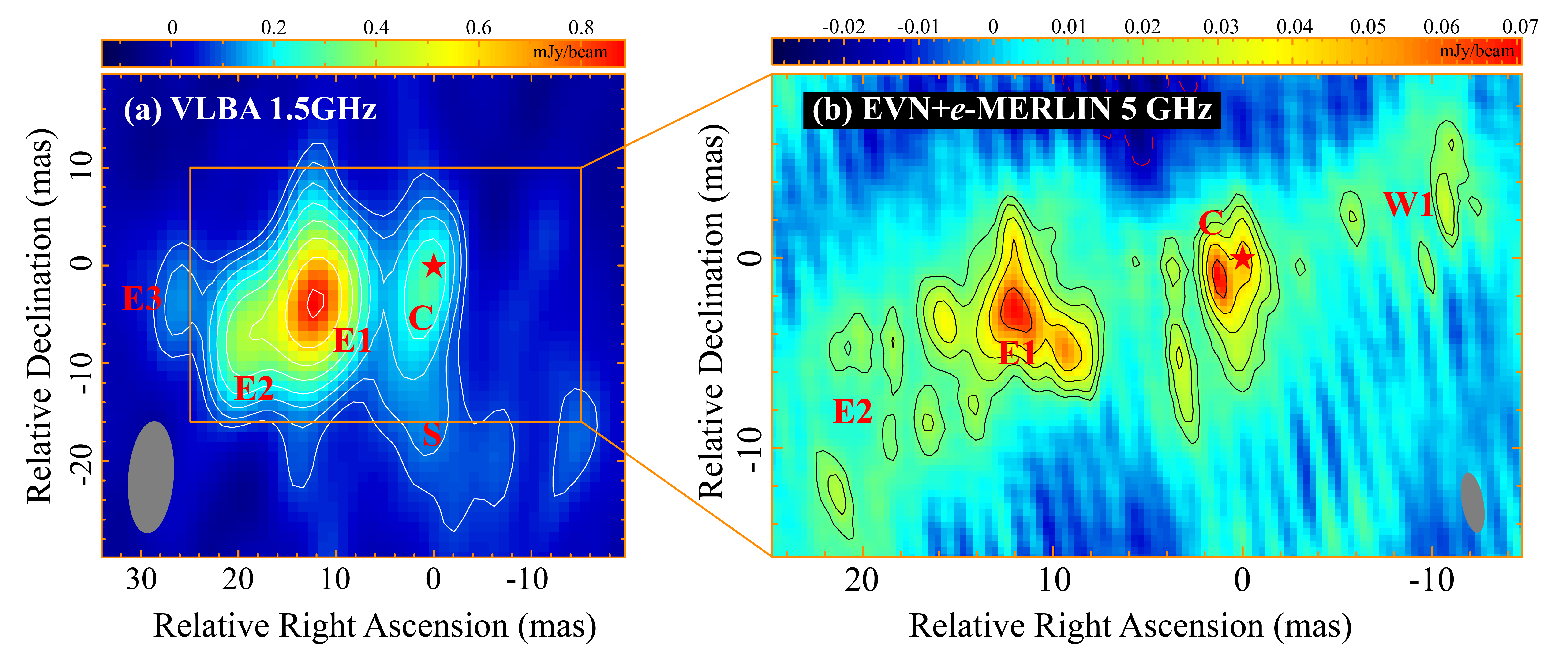
Small-scale Jets in the Rapidly Growing Supermassive Black Hole IZw1
Xiaolong Yang
Accretion of black holes at near- or super-Eddington rates is crucial for black hole growth and the co-evolution of supermassive black holes (SMBHs) and their host galaxies. However, the physics of accretion and jet–disk coupling in these extreme states remains poorly understood, largely due to the difficulty in detecting jets, which may emit weakly or intermittently. Although only a few near/super-Eddington systems have shown radio activity, it is unclear whether jets exist in these systems and, if so, what their properties are—particularly in super-Eddington active galactic nuclei (AGNs) and ultraluminous X-ray sources (ULXs). The complexity of radio emission in these systems, which can include contributions from jets, star formation, photoionized gas, accretion disk winds, and coronal activity, further adds to this uncertainty.
I Zw 1, an archetypal narrow-line Seyfert 1 galaxy at a redshift of z = 0.0589 (Ho & Kim 2009), provides a valuable case study for investigating these questions. With a black hole mass estimated at 9.3 × 10⁶ M☉ from optical reverberation mapping (Huang et al. 2019) and a bolometric luminosity exceeding its Eddington luminosity with an Eddington ratio of 2.77–4.20 (Martínez-Paredes et al. 2017), I Zw 1 represents a highly accreting, radio-quiet AGN.
We observed I Zw 1 on 2020 November 17, with 19 EVN antennas and e-MERLIN. Panel (b) of Figure 1 shows the 5 GHz EVN+eMERLIN observation, providing the highest resolution (3.22 × 1.14 mas) image of I Zw 1. In this image, the bright components seen at 1.5 GHz are resolved into a series of knots. Most of these components, except for S and W1, have brightness temperatures >10⁷ K, and the structure has a steep spectrum, suggesting a jet origin rather than star-forming activities or thermal radiation from an AGN's hot molecular disk. The bilateral radio structures in the 5 GHz EVN image are consistent with approaching and receding jets. The brightness asymmetry between the two branches may result from intrinsic jet differences, the surrounding ambient medium, or Doppler boosting. The absence of a prominent radio core in I Zw 1 could be due to free–free absorption by the torus, a hypothesis supported by previous studies. To further analyze the Doppler boosting effect, the brightness temperature ratio between the jet and counter-jet components (E1 and W1) at the C band is calculated as 1.135. Given the radio spectral index and estimated inclination angle (33°–51°), this suggests jet velocities between 0.025c and 0.034c. However, the lack of significant radio flux density variability weakens the case for strong Doppler boosting. Further investigations through kinematic measurements and flux density variability observations are necessary to clarify the Doppler boosting contribution to the observed jet asymmetry.

Figure 1: L and C-band VLBI images of I Zw 1. Panel (a) shows the VLBA 1.5 GHz image and Panel (b) shows the EVN+e-MERLIN 5 GHz image. The two images are produced with natural weight and the map reference is at the position of Gaia. The restoring beams are displayed as gray ellipses in the lower-left/right corner of each panel; their FWHMs and major axis position angles are 11.5 × 4.67 mas at −4°.3 and 3.22 × 1.14 mas at 10°.1 in panels (a) and (b), respectively. The contours are at 3σ × ( −1, 1, 1.41, 2, 2.83,...), where positive contours are shown in white (1.5 GHz) and black (5 GHz) solid lines, and negative contours are shown as red hash marks. The image peaks of 1.5 and 5 GHz images are 1.66 and 0.10 mJy/beam, respectively, and their rms noises are 0.06 and 0.007 mJy/beam, respectively. In each panel, the red star marks the Gaia optical position. The uncertainty in the position of Gaia is Δα = 0.18 and Δδ = 0.17 mas, which includes an astrometric excess noise error of 0.14 mas. At the redshift of I Zw 1, 1 mas corresponds to 1.125 pc.
Component S in the 1.5 GHz VLBA image (Figure 1, panel a) is confirmed as a real structure. It likely represents flux density missing at 5 GHz due to the loss of large-scale emission. Interestingly, S deviates from the jet's east–west trajectory, suggesting a jet–medium interaction. Given I Zw 1's alignment with a kiloparsec-scale molecular disk and the presence of strong multiscale outflows, component S might result from a jet-wind collision, supported by the observed outflows in various directions. Further identification is needed to confirm this interpretation.
Our study of I Zw 1 sheds new light on the enigmatic processes occurring in highly accreting AGNs. Despite its radio-quiet nature, with a radio-loudness parameter R = 0.35 (Yang et al. 2020), our VLBI observations uncovered small-scale jets in this system. These findings challenge the notion that radio-quiet AGNs lack significant jet activity and suggest that jets may be more common in near/super-Eddington systems than previously thought.
References:
Ho, L. C., & Kim, M. 2009, ApJS, 184, 398
Huang, Y.-K., Hu, C., Zhao, Y.-L., et al. 2019, ApJ, 876, 102
Martínez-Paredes, M., Aretxaga, I., Alonso-Herrero, A., et al. 2017, MNRAS, 468, 2
Yang, X., Yao, S., Yang, J., et al. 2020, ApJ, 904, 200
More information: Yang, X., Yao, S., Gallo, L.~C., et al. 2024, ApJ, 966, 151
Contact: yxl@pku.edu.cn